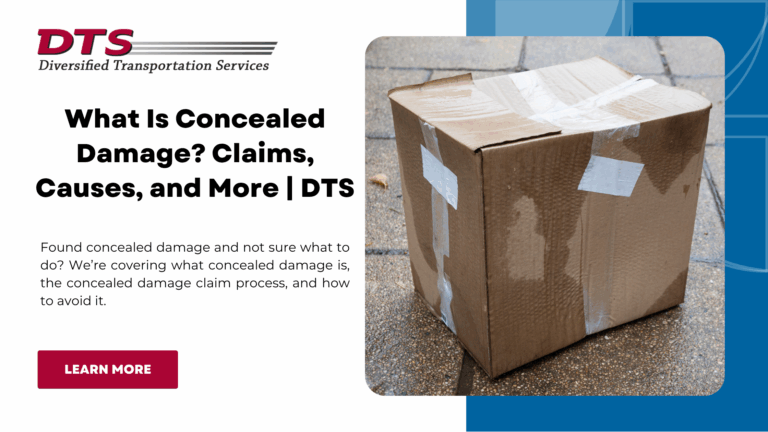Concealed damage: Meaning, causes, and how to file a claim
Imagine you receive a shipment of essential machinery or materials for your business. All seems well at first, but after examining the cargo up close, you discover damage that wasn’t initially clear.
Worse still, you’ve already signed for the shipment. What happens next?
You may be able to file a concealed damage freight claim. We’ll explain how to do this below, but let’s start with a breakdown of what concealed damage means and the most common causes.
What is concealed damage?
Shipments may occasionally be affected by concealed damage, meaning damage that’s only found once the delivery has been received. Issues won’t be immediately visible when they leave the carrier’s truck — they usually become apparent on closer inspection.
Concealed damage is particularly common in shipments involving fragile or sensitive items. Even if the packaging appears intact and pristine on the outside, the goods inside could still be broken, need to be repaired, or replaced.
What causes concealed damage?
Concealed damage can have several causes. It can happen randomly and for reasons completely outside of your control. But the most common causes and contributing factors include:
- Rough handling
- Insufficient packaging that’s too weak to protect items inside
- Improper loading and storage techniques (e.g., stacking heavy goods on top of packages)
- Environmental conditions (such as exposure to changing temperatures)
Any of these can lead to concealed damage. If you find concealed damage, you may need to file a concealed damage freight claim.
How to file a concealed damage claim
If you discover issues with your shipment after delivery, filing a claim quickly is crucial. How do you do that? Follow these simple steps:
- Inspect the shipment thoroughly as soon as possible after delivery.
- Document all signs of damage and take clear photos from multiple angles to prove that the goods are not in the expected condition. Keep the original packaging and take photos of it, as this may be required when filing a claim. You must also keep all damaged items as evidence.
- Report the damage to your carrier as soon as possible, ideally within five business days of receiving the shipment. Some carriers may place a time limit on claims, so contact them immediately after discovering any concealed damage.
- Your carrier will provide a form for your concealed damage freight claim. Fill this out and submit it within the permitted timeframe to avoid complications. Confirm the carrier’s claims deadline when contacting them to report the damage.
- Submit all required documentation and photos, and ask your carrier to confirm receipt if they don’t do so automatically. You may need to submit evidence of the shipment’s value, along with a delivery receipt, bill of lading, invoices, and other relevant documentation as part of your claim.
What happens after filing a claim?
Here’s what typically happens after filing a concealed damage claim:
- The carrier reviews the claim and may send an inspector to examine the shipment damage
- The damage will be evaluated carefully to determine whether it occurred during transit and if the carrier is liable
- The claim is either approved or denied
- If a claim is approved, the shipper or consignee may receive a refund, repair costs, or replacement value
- If denied, the carrier should provide a detailed explanation
- This process can take several weeks, depending on the carrier’s policies and claim complexity
Tips to avoid freight damage
Packaging shipments properly is critical to minimize the risk of them becoming damaged in transit. With this in mind, follow these tips to avoid freight damage:
- Use the right packaging materials for each shipment, ensuring that boxes are sturdy and using bubble wrap or other protective items for extra peace of mind
- Palletize and properly shrinkwrap goods to keep them stable on the road
- Avoid the cheapest packing materials, even if your budget isn’t as high as you might like — investing now will help you avoid the hassle of concealed damage later
- Work with a logistics partner that can offer expert advice based on years of experience
How DTS can help you
Filing a claim can be complicated and time-consuming, so it’s best to avoid it in the first place. Working with a logistics partner like DTS is a simple, effective way to navigate the claims process without the stress of trying to handle it all yourself.
Our professional team will guide you through each step of filing a claim and provide key shipping guidance to ensure your business keeps running smoothly. To learn more about how DTS can help, get in touch today.
